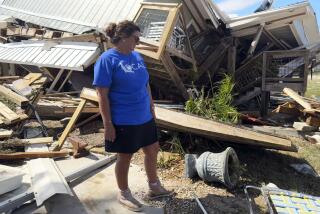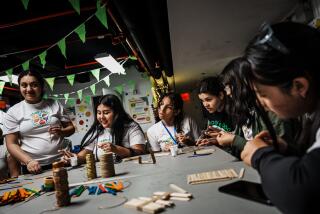Orphans of the Storm
- Share via
TEGUCIGALPA, Honduras — At age 6, Wilmer Alvarado was already well on his way to becoming a street kid when tropical storm Mitch swept him into the gutters of this flooded capital city.
Like thousands of other Honduran children, he had long played or begged in the street while his mother sold trinkets in the market. Such kids are always high-risk candidates, social workers say, for leaving home and wandering the streets.
In Wilmer’s case, Mitch turned risk into reality.
During the month since the storm killed 10,000 people across Central America and devastated his country, washing away both the market and the shantytown where he lived, Wilmer has joined the hundreds of children who live here full time in the streets. His mother has disappeared--at least from his life. And the little boy has developed a voracious glue-sniffing habit.
Wilmer is among the first victims of a problem that social workers here fear will explode when shelters for those left homeless by Mitch are closed early next year: They worry that absolute poverty--no home, no job and no prospects of finding either--and the family stress and violence that go with it will push more children onto the streets.
Estimates of the number of children living on Tegucigalpa’s streets before the storm range from 200 to 1,200. No one can keep track of these kids, who float between the homes of sympathetic friends or relatives, juvenile detention centers, drug rehabilitation programs and park benches.
But the consensus among social workers is that the number will skyrocket in the coming months. About 85,000 children are among storm victims living in shelters, most located in schools that must be vacated by the end of January to allow classes to resume.
“This risky situation assures that there will be an increase in the number of children in the streets,” said Jose Valladares, director of the government’s Childhood and Family Institute. “Situations of extreme poverty force children to abandon their families. The fundamental reason is domestic violence.”
In addition to first-time urchins such as Wilmer, children who had returned to their families are filtering back into halfway houses. Counselors are concerned that they may soon slip back onto the streets--and drugs.
Lure of Money Makes Streets Look Attractive
Besides the poverty and violence that push kids away from their families, the streets also have an almost magnetic pull for some youngsters that has increased with the chaos that the storm left.
“The streets have become more attractive,” said Giovany Velasquez, a counselor at Casa Alianza, a shelter for street kids that is affiliated with New York-based Covenant House.
Children can scavenge on the banks of receding rivers for goods to clean up and sell. With downtown traffic sharply restricted by damaged bridges and streets, more people are walking, increasing the number of targets for pickpockets.
“They are handling a lot more money, so they have been able to buy more drugs,” said Father Eduardo Martinez, who runs Centro Agape, a daytime center for street kids. Teenagers can now afford Valium, marijuana and even cocaine, he said, while younger children, such as Wilmer, spend their change on more glue.
However, that extra money--combined with a curfew to discourage looting--has exposed the kids to more police harassment, Martinez said. Freddy Ismael Carranza, 11, and Jose Luis Amador, 12, “found” a box of socks last week and were selling them on the bridge that has become an informal marketplace since the floods destroyed the municipal market.
“We were looking for a place to sleep when two cops came up,” Freddy said. “One grabbed me by the hair.”
Jose Luis took up the story: “I had about $3, so I gave it to them.”
Freddy concluded, “They beat us up anyway and told us not to be there when they got back.”
Police spokesman Hector Ivan Mejia said authorities cannot act on allegations of abuse unless victims file a complaint. In the past, children’s rights organizations have complained, he said, and at least one police officer was fired after an inquiry.
Complaints lead to revenge against the children, Martinez replied, making them reluctant to speak up. Still, neither the threat of police harassment nor the stench from mud-covered parks and sidewalks is enough to convince many children to give up the freedom of the streets.
Flash Floods Don’t Slow Down Children
Roy Mercado, a counselor at Casa Alianza, was shocked by how unaffected experienced street kids were by the flash floods that rose overnight Oct. 30, inundating buildings on riverbanks and causing massive mudslides that crushed hillside houses.
As soon as the storm stopped, Mercado hit the pavement to offer children dry beds and warm meals at Casa Alianza. He expected lots of takers: Street kids normally slept under bridges now lapped by swollen rivers or on a sports field in the usually dry river basin.
Imagine Mercado’s surprise when, sinking ankle-deep into mud while picking his way through debris, he ran into 10-year-old Belsi Rivera. “He asked me which game I was carrying,” said Mercado, who typically keeps a board game in his backpack as a means of establishing rapport with children.
“I was worried about getting him to safety, and he just wanted to play,” the counselor recalled. A few weeks later, Belsi climbed a wall and slid down a tree, trying to get breakfast and a change of clothes at Casa Alianza without the requisite lecture about drug use and responsibility.
Once caught, he greeted Mercado warmly; but when asked where he had been and why he lives in the street, he stuck his dirty fingers in his ears and screamed.
Roberto Aguirre, 14, answered succinctly about what keeps him in the street. “Glue,” he replied.
Most street kids’ days are spent getting glue, a substance sold commercially for shoe repair that contains the toxic chemical toluene. Glue containing that chemical is no longer sold in the United States.
The children sneak down to the shacks near a stadium, which Mitch left undamaged, to buy baby food jars filled with glue; or they make quick transactions with older kids in the middle of downtown.
Their horseplay is fighting over glue, the way other kids might fight over marbles. Any coins or food that they beg for or earn by washing cars is quickly exchanged for a dab of glue that they put in a plastic bag and inhale deeply.
When they have sniffed enough, they pass out, often curled up together. “They die very young, as if they were little animals,” said Valladares of the government institute.
During the five years that Father Martinez has spent in Tegucigalpa, nine of the children he worked with have died, a few of stab wounds, sometimes in cases that seemed to be suicides.
Now, the destruction caused by Mitch has threatened to draw back to the streets children who appeared to have escaped.
Kety Rosario Calix, 15, had been living with her stepmother for two months when Mitch swept away their modest house on a riverbank. “For me, there is nothing left in this life; the hurricane took it all,” she said at Casa Alianza, where she was brought by an adult who found her wandering the streets.
She had been there before. While living with her birth mother, Kety Rosario had been sent out on the streets to sell gum. The girl soon found that she liked life there better than living with her abusive stepfather.
At 7, she began staying out and sniffing glue. “The glue took away the hunger, the sleepiness, the cold,” she said.
When she did go home, her mother beat her as punishment for her drug habit. One day, the girl threatened her mother with a knife and was kicked out of the house.
Girl Ends Drug Use, but Life Still ‘Disaster’
Kety Rosario ended up at Casa Alianza. She kicked her drug habit quickly and with the counselors’ help located her grandparents, who two years ago agreed to raise her. When she grew bored in the country, her father and stepmother let her live with them in the capital.
With weekly visits from a counselor and a small scholarship to buy school supplies, she was adapting to life with them.
Then came Mitch. Kety Rosario said her stepmother may have drowned in the flooding and her father was out of town working. She does not know where to find him.
She has heard that her mother is staying in a shelter. Kety Rosario sees little hope of returning to live with her mother, who has given up on the girl since the knife incident. “My life has always been a disaster,” the teenager said.
“She is not a girl who likes to be out in the street,” said Mercado of Casa Alianza. “She is separated from her family because of extreme poverty.”
He worries that Honduras will have many more Kety Rosarios next year.
“When there are no more shelters, when there is no more government help,” he predicted, “then, we are going to see a lot more kids in the street.”
(BEGIN TEXT OF INFOBOX / INFOGRAPHIC)
How to Help For Southern Californians who want to help, here are some of the organizations accepting financial contributions to assist Central America flood victims. Checks should be marked for Hurricane Mitch Relief Effort:
* The Christian Children’s Fund, through their headquarters at 2821 Emerywood Parkway, Richmond, VA 23294. (804) 756-2780.
* The Honduran Consulate is accepting food, medicine, water, clothing and financial donations through ASOSAL, 660 S. Bonnie Brae St., Los Angeles 90057. (213) 483-1244.
* The American Red Cross, 2700 Wilshire Blvd., Los Angeles 90057, or credit card contributions can be made by calling (800) 435-7669; in Spanish, (800) 257-7575.
* CARE, 151 Ellis St. NE, Atlanta, GA 30303-2426. (800) 422-7385.
* Church World Services, 28606 Phillips St., P.O. Box 968, Elkhart, IN 46515. (800) 297-1516, ext. 222.
* Save the Children, Hurricane Mitch Emergency Appeal, P.O. Box 975-M, 54 Wilton Road, Westport, CT 06880. (800) 243-5075.
More to Read
Sign up for Essential California
The most important California stories and recommendations in your inbox every morning.
You may occasionally receive promotional content from the Los Angeles Times.









